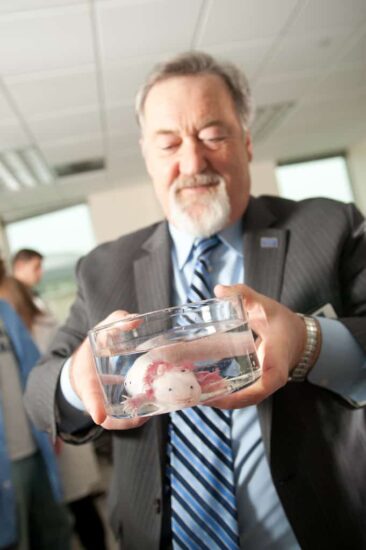Miracles of the Heart

Dr. Larry Lemanski's interest in embryonic cardiac development initiated his study of the Mexican axolotl, an aquatic salamander with a cardiac lethal mutation that can cause its heart to fail to beat. Through experimentation, Lemanski, Distinguished Research Professor and head of the department of biological and environmental sciences, and his research team found that adding the cardiac tissue of normal axolotl embryos to the mutant hearts would cause them to beat. Further investigation revealed that the chemical that made this possible was ribonucleic acid (RNA).
After identifying the active portion of the axolotl's RNA that causes the rescue of the mutant hearts—a substance the group has termed Myofibril-Inducing RNA (MIR)—the researchers explored other species options. Tests with the cardiac MIR of sheep and later on, that of adult humans, have shown that the MIR of other animals would also rescue those mutant axolotl hearts. However, the group's most interesting finding may be that when the MIR of humans is added to skin or stem cells—rather than cells from the heart—they also transform into functioning cardiac muscle cells.
“If we can understand this totally and apply it to clinical medicine, we could have people who have had heart attacks or have cardiac disease be able to repair their own hearts by taking their own skin, treating it with this RNA, causing it to form into cardiac tissue and putting it on their hearts to repair them,” said Lemanski.
“Such an approach would change the way heart failure is being treated in that new muscle would replace the scar tissue, and these patients could then return to pre-heart attack activities.”
While funding from the National Institutes of Health (NIH) and the American Heart Association (AHA) has made the initial research possible, Lemanski has applied for additional grant funding from the NIH to support the research to repair heart attack damage in mice, a step in learning the prospects for humans.
“If you can take a skin cell and make it form into a heart cell, maybe you can take a skin cell and make it form into a nerve cell or any other cell,” said Lemanski.
The possibilities have led Lemanski to submit proposals for patents on the MIR. The Texas A&M University System is currently reviewing them and final plans for the submission of a provisional patent are in the works—as is consideration for future pharmaceutical production and commercialization.


